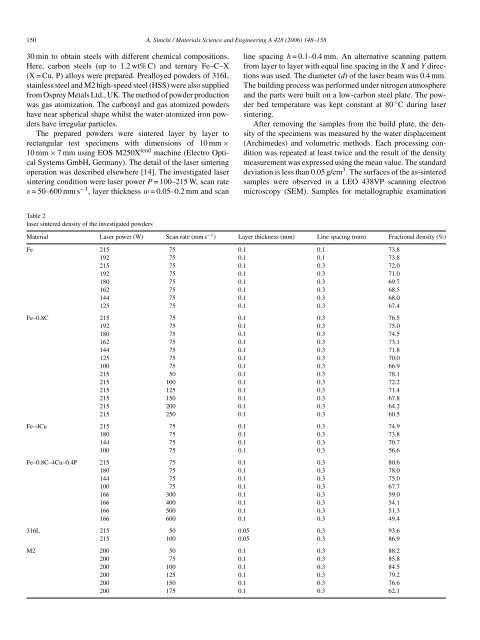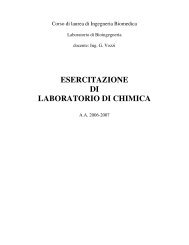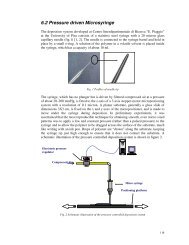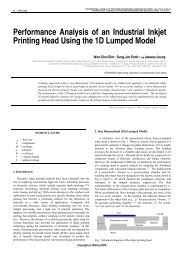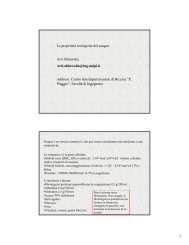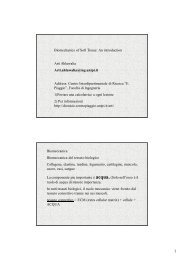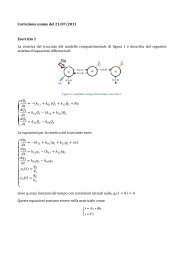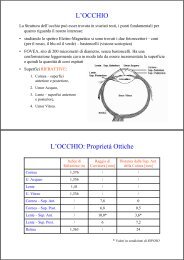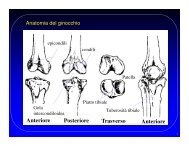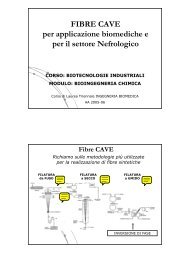A. Simchi / Materials Science <strong>and</strong> Engineering A 428 (2006) 148–158 149NomenclatureC heat capacity (J/kg K)d beam diameter (mm)D n particle size at n pct <strong>of</strong> the cumulative particle sizedistribution (m)h scan line spacing (mm)H latent heat <strong>of</strong> fusion (J/kg)K densification coefficient, Eq. (10)k ′ <strong>sintering</strong> ratel scan vector length (mm)O fraction <strong>of</strong> overlap, Eq. [3]P <strong>laser</strong> power (W)Q <strong>laser</strong> energy density (J/mm 2 )¯Q delivered energy per volume <strong>of</strong> each <strong>laser</strong> track(J/mm 3 )S w particle size distribution slopeT temperature (K)v scan rate (mm/s)v ∗ dimensionless velocityw layer thickness (mm)Greek symbolsε void fractionρ fractional densityτ delay period between successive irradiationψ <strong>laser</strong> energy input per volume <strong>of</strong> sintered specimen(kJ/mm 3 )η coupling efficiencySubscriptsb bedo initials <strong>sintering</strong>ture <strong>and</strong> thus on the process variables, it is important to developa <strong>sintering</strong> model. A <strong>sintering</strong> model allows one to perform aparametric analysis to study how variations in one parameteraffect the sintered density or <strong>sintering</strong> depth within a powderbed.In the indirect <strong>laser</strong> <strong>sintering</strong> process, i.e. selective <strong>laser</strong> <strong>sintering</strong>,which originated by the University <strong>of</strong> Texas at Austin,a polymer phase is used for powder particles bonding. During<strong>laser</strong> irradiation, the polymer phase is melted <strong>and</strong> upon cooling,it bonds the powder particles together [10]. The <strong>sintering</strong> mechanismis viscous flow <strong>and</strong> the surface energy reduction drivesthe mass flow dissipation. Although modeling <strong>of</strong> <strong>laser</strong> <strong>sintering</strong>rates for real systems is difficult <strong>and</strong> in many cases may not provideaccurate results, isothermal <strong>sintering</strong> rates <strong>of</strong> amorphousmaterials can be used. For instance, Nelson [11] assumed thatthe <strong>sintering</strong> rate is a function <strong>of</strong> temperature according to Arrheniusequation. Sun [12] related the <strong>sintering</strong> height to the <strong>laser</strong>power <strong>and</strong> <strong>laser</strong> velocity by simple empirical equations. Bugedaet al. [13] considered the powder bed as an open pore network<strong>of</strong> cylinders <strong>and</strong> evaluated the sintered density as a function <strong>of</strong>time <strong>and</strong> temperature according to the Mackenzie–Shuttleworthmodel.Unlike polymer materials, liquid phase <strong>sintering</strong> <strong>and</strong> melting/solidificationapproach are the mechanisms feasible for rapidbonding <strong>of</strong> powder particles in the direct <strong>laser</strong> <strong>sintering</strong> process(DMLS) [10]. So far, no much work has been performedto systematically investigate the <strong>sintering</strong> rate <strong>and</strong> densification<strong>of</strong> <strong>metal</strong> <strong>powders</strong> during DMLS. Since the process is very fast<strong>and</strong> complex, the existing isothermal <strong>sintering</strong> models are notadequate. For advanced theoretical <strong>and</strong> simulation studies, it isimperative to underst<strong>and</strong> the <strong>sintering</strong> mechanism <strong>and</strong> <strong>kinetics</strong>.The effect <strong>of</strong> processing parameters on the microstructuralfeatures need to be established. This study is focused on parametersinvolved in determining the method <strong>of</strong> energy delivered tothe powder medium, <strong>and</strong> to relate them to the <strong>sintering</strong> rate.Based on the empirical results, the mechanism <strong>of</strong> densification<strong>and</strong> microstructural evolution during DMLS are addressed.Although ferrous <strong>powders</strong> were used in the present work, theresults are generic <strong>and</strong> can be applied for other <strong>metal</strong> <strong>powders</strong>.2. ExperimentalTable 1 gives the particle characteristics <strong>of</strong> iron <strong>and</strong> steel<strong>powders</strong> used as the starting materials. The particle size distributionwas determined using a Coulter LS130 (Beckman CoulterGmbH, Krefeld, Germany) <strong>laser</strong> particle size analyzer. Exceptcarbonyl iron powder, the other iron <strong>powders</strong> were produced bythe water atomization process. In this case, sieving was usedto obtain different particle sizes ranging from 10 to 200 m.Graphite (2 m, Aldrich), copper (
150 A. Simchi / Materials Science <strong>and</strong> Engineering A 428 (2006) 148–15830 min to obtain steels with different chemical compositions.Here, carbon steels (up to 1.2 wt% C) <strong>and</strong> ternary Fe–C–X(X = Cu, P) alloys were prepared. Prealloyed <strong>powders</strong> <strong>of</strong> 316Lstainless steel <strong>and</strong> M2 high-speed steel (HSS) were also suppliedfrom Osprey Metals Ltd., UK. The method <strong>of</strong> powder productionwas gas atomization. The carbonyl <strong>and</strong> gas atomized <strong>powders</strong>have near spherical shape whilst the water-atomized iron <strong>powders</strong>have irregular particles.The prepared <strong>powders</strong> were sintered layer by layer torectangular test specimens with dimensions <strong>of</strong> 10 mm ×10 mm × 7 mm using EOS M250X tend machine (Electro OpticalSystems GmbH, Germany). The detail <strong>of</strong> the <strong>laser</strong> <strong>sintering</strong>operation was described elsewhere [14]. The investigated <strong>laser</strong><strong>sintering</strong> condition were <strong>laser</strong> power P = 100–215 W, scan ratev = 50–600 mm s −1 , layer thickness w = 0.05–0.2 mm <strong>and</strong> scanline spacing h = 0.1–0.4 mm. An alternative scanning patternfrom layer to layer with equal line spacing in the X <strong>and</strong> Y directionswas used. The diameter (d) <strong>of</strong> the <strong>laser</strong> beam was 0.4 mm.The building process was performed under nitrogen atmosphere<strong>and</strong> the parts were built on a low-carbon steel plate. The powderbed temperature was kept constant at 80 ◦ C during <strong>laser</strong><strong>sintering</strong>.After removing the samples from the build plate, the density<strong>of</strong> the specimens was measured by the water displacement(Archimedes) <strong>and</strong> volumetric methods. Each processing conditionwas repeated at least twice <strong>and</strong> the result <strong>of</strong> the densitymeasurement was expressed using the mean value. The st<strong>and</strong>arddeviation is less than 0.05 g/cm 3 . The surfaces <strong>of</strong> the as-sinteredsamples were observed in a LEO 438VP scanning electronmicroscopy (SEM). Samples for <strong>metal</strong>lographic examinationTable 2<strong>laser</strong> sintered density <strong>of</strong> the investigated <strong>powders</strong>Material Laser power (W) Scan rate (mm s −1 ) Layer thickness (mm) Line spacing (mm) Fractional density (%)Fe 215 75 0.1 0.1 73.8192 75 0.1 0.1 73.8215 75 0.1 0.3 72.0192 75 0.1 0.3 71.0180 75 0.1 0.3 69.7162 75 0.1 0.3 68.5144 75 0.1 0.3 68.0125 75 0.1 0.3 67.4Fe–0.8C 215 75 0.1 0.3 76.5192 75 0.1 0.3 75.0180 75 0.1 0.3 74.5162 75 0.1 0.3 73.1144 75 0.1 0.3 71.8125 75 0.1 0.3 70.0100 75 0.1 0.3 66.9215 50 0.1 0.3 78.1215 100 0.1 0.3 72.2215 125 0.1 0.3 71.4215 150 0.1 0.3 67.8215 200 0.1 0.3 64.2215 250 0.1 0.3 60.5Fe–4Cu 215 75 0.1 0.3 74.9180 75 0.1 0.3 73.8144 75 0.1 0.3 70.7100 75 0.1 0.3 56.6Fe–0.8C–4Cu–0.4P 215 75 0.1 0.3 80.6180 75 0.1 0.3 78.0144 75 0.1 0.3 75.0100 75 0.1 0.3 67.7166 300 0.1 0.3 59.0166 400 0.1 0.3 54.1166 500 0.1 0.3 51.3166 600 0.1 0.3 49.4316L 215 50 0.05 0.3 93.6215 100 0.05 0.3 86.9M2 200 50 0.1 0.3 88.2200 75 0.1 0.3 85.8200 100 0.1 0.3 84.5200 125 0.1 0.3 79.2200 150 0.1 0.3 76.6200 175 0.1 0.3 62.1


